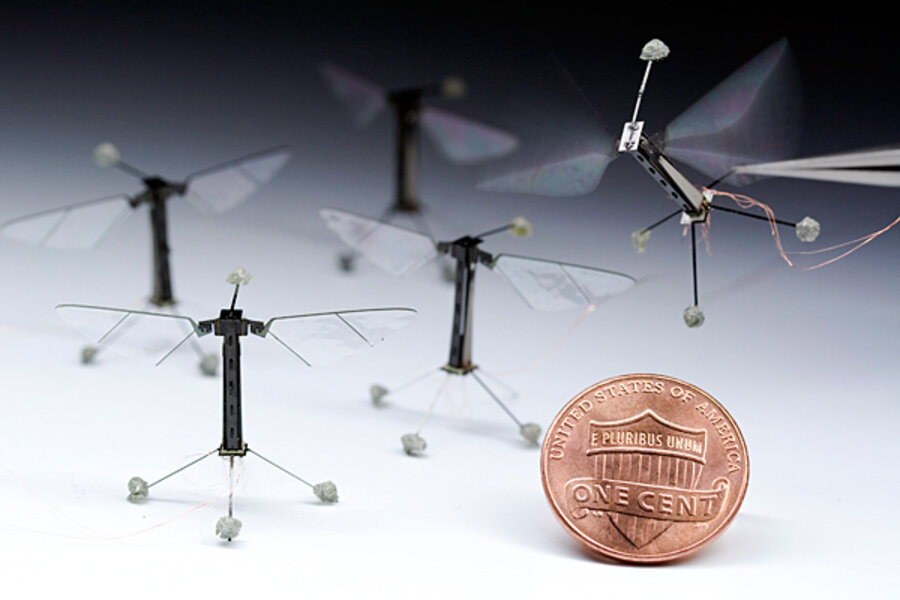Flight of the RoboBee: Tiny hovering robot creates buzz
Loading...
A robotic fly with a body not much taller than a penny standing on edge has taken to the air, passing its tests with flying colors. The RoboBee, as it's called, is the smallest artificial insect yet flown, according to the team that built it.
It lifts off the table, hovers, and flies in different directions. At this point in its evolution, the bug is still tethered by thin wires that allow its designers to power and guide it. And landing remains an issue. The robot ends its sorties with all the grace of a mosquito nailed with a burst of Raid.
Still, the tiny craft's success – the team that designed it said it was the first such object to fly in a controlled manner – represents a key step in developing insect-size drones that designers say could one day search collapsed buildings for survivors after a disaster, sample an environment for hazardous chemicals before humans are sent in, or pinpoint enemy soldiers or terrorists holed up in urban areas.
Some members of the team suggest that future generations of the bug could serve as a robotic pollinator for plants, though without the side benefit of honey.
Over the years, researchers have marveled at insect flight in no small part because it appears to violate every principle that keeps a bird or an airliner aloft.
Together with an announcement this week that another team of researchers has developed a buglike compound lens for collecting video taken with small aerial vehicles, the description of RoboBee appearing in Friday's issue of the journal Science signals how far robotic bug research has come in the past decade.
"Just fantastic," enthuses John Rogers, who heads the Seitz Materials Research Laboratory at the University of Illinois at Urbana-Champaign, when asked about RoboBee. Dr. Rogers guided the team that developed the artificial compound lens.
RoboBee is something of a misnomer. The team modeled its bug after a hoverfly, which looks like a bee. Hoverflies show remarkable control over their movements – from hovering, as the name implies, to lightly touching down on a wind-tossed blossom.
The hoverfly wanna-be was built by researchers and graduate students at Harvard University and weighs a scant .003 ounces. Its wingspan stretches just over an inch, and its wings flap as many as 120 times a second, with each stroke covering an angle of 110 degrees – all comparable to a hoverfly's characteristics. Each of the two independently controlled wings weighs about .00003 of an ounce.
The bug is far too small for hardware typically used in robots as stand-ins for muscles and joints, so the team "had to develop solutions from scratch, for everything," said Harvard engineering professor Robert Wood, who led the team, in a prepared statement.
The body of the bug was made from carbon-fiber composites with thin plastic strips serving as joints. The team crafted muscles from thin layers of ceramics that expand and contract when electricity is applied to them. The bug's overall power consumption is a paltry .019 of a watt – so little that a flashlight bulb seems like an energy hog in comparison.
Over the past two years, the team has refined the manufacturing process to such a degree that they can replace a bug that augers in fairly quickly. In the past six months, the team has gone through 20 prototypes, according to Kevin Ma, a graduate student at Harvard's School of Engineering and Applied Sciences and one of two lead authors on the formal research paper appearing in Science.
The team's next challenge is to gradually move the bug from being tethered to being increasingly autonomous. At some point, that means it needs to see where it's going.
One potential solution appears in Thursday's issue of the journal Nature, where an international team – including Kenneth Crozier, with Harvard's School of Engineering and Applied Sciences – formally unveiled an artificial eye similar in design to the eyes of a fire ant or bark beetle. It boasts an array of 256 microlenses, 180 of which are used for imaging. Each of these imaging lenses sits atop a light sensor. All sit in tidy order on a half sphere.
In nature, this arrangement gives insects an extraordinary field of view and an ability to keep virtually everything they see in focus, no matter how close or distant.
In the past, researchers have developed layouts that mimic to some degree a compound eye, but the arrays have been either flat or hemispherical but laboriously handcrafted.
The team guided by the University of Illinois's Rogers found a way to use elastic materials to give the overall array the shape it needed without throwing the microlenses and the light sensors each was paired with out of alignment. The compound lens is just under half an inch wide.
In an e-mail, Rogers says the team hopes to improve the compound lenses' resolution – its ability to distinguish between two closely spaced objects. Indeed, he says he's confident that the approach will yield lenses that outperform even the best insect eyes.
"We are working on that, and on schemes that allow the overall size of the camera to be reduced," he says, including a size befitting a RoboBee.






